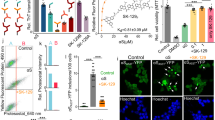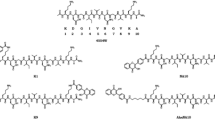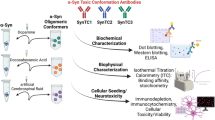Abstract
Aggregation of an amyloid protein, α-synuclein (αS), is a critical step in the neurodegenerative pathway of Parkinson’s diseases (PD). Specific detection of amyloid conformers (i.e., monomers, oligomers, and fibrils) produced during αS aggregation is critical in better understanding a molecular basis of PD and developing a diagnostic tool. While various molecular probes are available for detection of αS fibrils, which may serve as a reservoir of toxic αS aggregate forms, these probes suffer from limited conformer-specificity and operational flexibility. In the present study, we explored the potential of non-self-aggregating peptides derived from the highly aggregation-prone KLVFFAE region of an amyloid protein, β-amyloid, as molecular probes for αS aggregates. We show that of the four peptides tested (KLVFWAK, ELVFWAE, and their C-terminal capping variants, all of which were attached with fluorescein isothiocyanate at their respective N-termini), KLVFWAK with C-terminal capping was selectively bound to αS fibrils over monomers and oligomers and readily used for monitoring αS fibrilization. Our analyses suggest that binding of the peptide to αS fibrils is mediated by both electrostatic and hydrophobic interactions. We anticipate that our peptide can readily be optimized for conformer-specificity and operational flexibility. Overall, this study presents the creation of a KLVFFAE-based molecular probe for αS fibrils and demonstrates fine-tuning of its conformer-specificity by terminal mutations and capping.



Similar content being viewed by others
References
Reiss, A. B., Arain, H. A., Stecker, M. M., Siegart, N. M., & Kasselman, L. J. (2018). Amyloid toxicity in Alzheimer's disease. Reviews in the Neurosciences, 29(6), 613–627.
Lashuel, H. A., Overk, C. R., Oueslati, A., & Masliah, E. (2013). The many faces of alpha-synuclein: from structure and toxicity to therapeutic target. Nature Reviews. Neuroscience, 14(1), 38–48.
Buell, A. K., Galvagnion, C., Gaspar, R., Sparr, E., Vendruscolo, M., Knowles, T. P., Linse, S., & Dobson, C. M. (2014). Solution conditions determine the relative importance of nucleation and growth processes in alpha-synuclein aggregation. Proceedings of the National Academy of Sciences of the United States of America, 111(21), 7671–7676.
Tipping, K. W., van Oosten-Hawle, P., Hewitt, E. W., & Radford, S. E. (2015). Amyloid fibres: inert end-stage aggregates or key players in disease? Trends in Biochemical Sciences, 40(12), 719–727.
Tipping, K. W., Karamanos, T. K., Jakhria, T., Iadanza, M. G., Goodchild, S. C., Tuma, R., Ranson, N. A., Hewitt, E. W., & Radford, S. E. (2015). pH-induced molecular shedding drives the formation of amyloid fibril-derived oligomers. Proceedings of the National Academy of Sciences of the United States of America, 112(18), 5691–5696.
Koffie, R. M., Meyer-Luehmann, M., Hashimoto, T., Adams, K. W., Mielke, M. L., Garcia-Alloza, M., Micheva, K. D., Smith, S. J., Kim, M. L., Lee, V. M., Hyman, B. T., & Spires-Jones, T. L. (2009). Oligomeric amyloid beta associates with postsynaptic densities and correlates with excitatory synapse loss near senile plaques. Proceedings of the National Academy of Sciences of the United States of America, 106(10), 4012–4017.
Cremades, N., Cohen, S. I., Deas, E., Abramov, A. Y., Chen, A. Y., Orte, A., Sandal, M., Clarke, R. W., Dunne, P., Aprile, F. A., Bertoncini, C. W., Wood, N. W., Knowles, T. P., Dobson, C. M., & Klenerman, D. (2012). Direct observation of the interconversion of normal and toxic forms of alpha-synuclein. Cell, 149(5), 1048–1059.
Cho, J. E., & Kim, J. R. (2011). Recent approaches targeting beta-amyloid for therapeutic intervention of Alzheimer's disease. Recent Patents on CNS Drug Discovery, 6(3), 222–233.
Madav, Y., Wairkar, S., & Prabhakar, B. (2019). Recent therapeutic strategies targeting beta amyloid and tauopathies in Alzheimer's disease. Brain Research Bulletin, 146, 171–184.
Irvine, G. B., El-Agnaf, O. M., Shankar, G. M., & Walsh, D. M. (2008). Protein aggregation in the brain: the molecular basis for Alzheimer's and Parkinson's diseases. Molecular Medicine, 14(7-8), 451–464.
Hu, Y., Su, B., Zheng, H., & Kim, J. R. (2012). A peptide probe for detection of various beta-amyloid oligomers. Molecular BioSystems, 8(10), 2741–2752.
Reinke, A. A., & Gestwicki, J. E. (2011). Insight into amyloid structure using chemical probes. Chemical Biology & Drug Design, 77(6), 399–411.
Biancalana, M., & Koide, S. (2010). Molecular mechanism of Thioflavin-T binding to amyloid fibrils. Biochimica et Biophysica Acta, 1804(7), 1405–1412.
Wu, C., Wang, Z., Lei, H., Duan, Y., Bowers, M. T., & Shea, J. E. (2008). The binding of thioflavin T and its neutral analog BTA-1 to protofibrils of the Alzheimer's disease Abeta(16-22) peptide probed by molecular dynamics simulations. Journal of Molecular Biology, 384(3), 718–729.
Ryan, D. A., Narrow, W. C., Federoff, H. J., & Bowers, W. J. (2010). An improved method for generating consistent soluble amyloid-beta oligomer preparations for in vitro neurotoxicity studies. Journal of Neuroscience Methods, 190(2), 171–179.
Maezawa, I., Hong, H. S., Liu, R., Wu, C. Y., Cheng, R. H., Kung, M. P., Kung, H. F., Lam, K. S., Oddo, S., Laferla, F. M., & Jin, L. W. (2008). Congo red and thioflavin-T analogs detect Abeta oligomers. Journal of Neurochemistry, 104(2), 457–468.
Naiki, H., Higuchi, K., Hosokawa, M., & Takeda, T. (1989). Fluorometric determination of amyloid fibrils in vitro using the fluorescent dye, thioflavin T1. Analytical Biochemistry, 177(2), 244–249.
Crystal, A. S., Giasson, B. I., Crowe, A., Kung, M. P., Zhuang, Z. P., Trojanowski, J. Q., & Lee, V. M. (2003). A comparison of amyloid fibrillogenesis using the novel fluorescent compound K114. Journal of Neurochemistry, 86(6), 1359–1368.
Lindgren, M., Sorgjerd, K., & Hammarstrom, P. (2005). Detection and characterization of aggregates, prefibrillar amyloidogenic oligomers, and protofibrils using fluorescence spectroscopy. Biophysical Journal, 88(6), 4200–4212.
Schmidt, M. L., Schuck, T., Sheridan, S., Kung, M. P., Kung, H., Zhuang, Z. P., Bergeron, C., Lamarche, J. S., Skovronsky, D., Giasson, B. I., Lee, V. M., & Trojanowski, J. Q. (2001). The fluorescent Congo red derivative, (trans, trans)-1-bromo-2,5-bis-(3-hydroxycarbonyl-4-hydroxy)styrylbenzene (BSB), labels diverse beta-pleated sheet structures in postmortem human neurodegenerative disease brains. The American Journal of Pathology, 159(3), 937–943.
Volkova, K. D., Kovalska, V. B., Balanda, A. O., Vermeij, R. J., Subramaniam, V., Slominskii, Y. L., & Yarmoluk, S. M. (2007). Cyanine dye-protein interactions: looking for fluorescent probes for amyloid structures. Journal of Biochemical and Biophysical Methods, 70(5), 727–733.
Reinke, A. A., Abulwerdi, G. A., & Gestwicki, J. E. (2010). Quantifying prefibrillar amyloids in vitro by using a "thioflavin-like" spectroscopic method. Chembiochem, 11(13), 1889–1895.
Lee, D., Kim, S. M., Kim, H. Y., & Kim, Y. (2019). Fluorescence chemicals to detect insoluble and soluble amyloid-beta aggregates. ACS Chemical Neuroscience, 10(6), 2647–2657.
Klunk, W. E., Jacob, R. F., & Mason, R. P. (1999). Quantifying amyloid beta-peptide (A beta) aggregation using the Congo red A beta (CR-A beta) spectrophotometric assay. Analytical Biochemistry, 266(1), 66–76.
Rouet, R., Lowe, D., & Christ, D. (2014). Stability engineering of the human antibody repertoire. FEBS Letters, 588(2), 269–277.
Aoraha, E., Candreva, J., & Kim, J. R. (2015). Engineering of a peptide probe for beta-amyloid aggregates. Molecular BioSystems, 11(8), 2281–2289.
Candreva, J., Chau, E., Aoraha, E., Nanda, V., & Kim, J. R. (2018). Hetero-assembly of a dual beta-amyloid variant peptide system. Chemical Communications (Cambridge), 54(49), 6380–6383.
Charlton, T., Shah, V., Lynch, T., Candreva, J., Chau, E., Yang, Y., Kim, H., Wood, A., & Kim, J. R. (2018). Amyloid aggregation of Bacillus circulans xylanase under native conditions and its modulation by beta-amyloid-derived peptide fragments. Chembiochem, 19(24), 2566–2574.
Tao, K., Wang, J., Zhou, P., Wang, C., Xu, H., Zhao, X., & Lu, J. R. (2011). Self-assembly of short abeta(16-22) peptides: effect of terminal capping and the role of electrostatic interaction. Langmuir, 27(6), 2723–2730.
Conway, K. A., Harper, J. D., & Lansbury, P. T. (1998). Accelerated in vitro fibril formation by a mutant alpha-synuclein linked to early-onset Parkinson disease. Nature Medicine, 4(11), 1318–1320.
Greenbaum, E. A., Graves, C. L., Mishizen-Eberz, A. J., Lupoli, M. A., Lynch, D. R., Englander, S. W., Axelsen, P. H., & Giasson, B. I. (2005). The E46K mutation in alpha-synuclein increases amyloid fibril formation. The Journal of Biological Chemistry, 280(9), 7800–7807.
Tashiro, M., Kojima, M., Kihara, H., Kasai, K., Kamiyoshihara, T., Ueda, K., & Shimotakahara, S. (2008). Characterization of fibrillation process of alpha-synuclein at the initial stage. Biochemical and Biophysical Research Communications, 369(3), 910–914.
Hernandez, M., Hu, Y., & Kim, J. R. (2013). A conformation-switching fluorescent protein probe for detection of alpha synuclein oligomers. Chemical Communications (Cambridge), 49(91), 10712–10714.
Hernandez, M., Golbert, S., Zhang, L. G., & Kim, J. R. (2011). Creation of aggregation-defective alpha-synuclein variants by engineering the sequence connecting beta-strand-forming domains. Chembiochem, 12(17), 2630–2639.
Celej, M. S., Sarroukh, R., Goormaghtigh, E., Fidelio, G. D., Ruysschaert, J. M., & Raussens, V. (2012). Toxic prefibrillar alpha-synuclein amyloid oligomers adopt a distinctive antiparallel beta-sheet structure. Biochemical Journal, 443(3), 719–726.
McMasters, M. J., Hammer, R. P., & McCarley, R. L. (2005). Surface-induced aggregation of beta amyloid peptide by co-substituted alkanethiol monolayers supported on gold. Langmuir, 21(10), 4464–4470.
Greenfield, N. J. (2006). Using circular dichroism spectra to estimate protein secondary structure. Nature Protocols, 1(6), 2876–2890.
Kim, J. R., & Murphy, R. M. (2004). Mechanism of accelerated assembly of beta-amyloid filaments into fibrils by KLVFFK(6). Biophysical Journal, 86(5), 3194–3203.
Der-Sarkissian, A., Jao, C. C., Chen, J., & Langen, R. (2003). Structural organization of alpha-synuclein fibrils studied by site-directed spin labeling. The Journal of Biological Chemistry, 278(39), 37530–37535.
Chen, M., Margittai, M., Chen, J., & Langen, R. (2007). Investigation of alpha-synuclein fibril structure by site-directed spin labeling. The Journal of Biological Chemistry, 282(34), 24970–24979.
Heise, H., Hoyer, W., Becker, S., Andronesi, O. C., Riedel, D., & Baldus, M. (2005). Molecular-level secondary structure, polymorphism, and dynamics of full-length alpha-synuclein fibrils studied by solid-state NMR. Proceedings of the National Academy of Sciences of the United States of America, 102(44), 15871–15876.
Tuttle, M. D., Comellas, G., Nieuwkoop, A. J., Covell, D. J., Berthold, D. A., Kloepper, K. D., Courtney, J. M., Kim, J. K., Barclay, A. M., Kendall, A., Wan, W., Stubbs, G., Schwieters, C. D., Lee, V. M., George, J. M., & Rienstra, C. M. (2016). Solid-state NMR structure of a pathogenic fibril of full-length human alpha-synuclein. Nature Structural & Molecular Biology, 23(5), 409–415.
Qin, Z., Hu, D., Han, S., Hong, D. P., & Fink, A. L. (2007). Role of different regions of alpha-synuclein in the assembly of fibrils. Biochemistry, 46(46), 13322–13330.
Apetri, M. M., Maiti, N. C., Zagorski, M. G., Carey, P. R., & Anderson, V. E. (2006). Secondary structure of alpha-synuclein oligomers: characterization by raman and atomic force microscopy. Journal of Molecular Biology, 355(1), 63–71.
Stsiapura, V. I., Maskevich, A. A., Kuzmitsky, V. A., Turoverov, K. K., & Kuznetsova, I. M. (2007). Computational study of thioflavin T torsional relaxation in the excited state. The Journal of Physical Chemistry. A, 111(22), 4829–4835.
Rahbarnia, L., Farajnia, S., Babaei, H., Majidi, J., Veisi, K., Ahmadzadeh, V., & Akbari, B. (2017). Evolution of phage display technology: from discovery to application. Journal of Drug Targeting, 25(3), 216–224.
Wan, J., & Alewood, P. F. (2016). Peptide-decorated dendrimers and their bioapplications. Angewandte Chemie (International Ed. in English), 55(17), 5124–5134.
Acknowledgments
The research reported in this article was supported by the NIH/NIA Grant R21AG049137. We thank the Small Instrument Fleet of New York University (NYULMC) for the use of the Typhoon Trio Phosphoimaging System.
Author information
Authors and Affiliations
Corresponding author
Ethics declarations
Conflict of Interest
The authors declare that they have no conflict of interest.
Additional information
Publisher’s Note
Springer Nature remains neutral with regard to jurisdictional claims in published maps and institutional affiliations.
Rights and permissions
About this article
Cite this article
Wood, A., Chau, E., Yang, Y. et al. A KLVFFAE-Derived Peptide Probe for Detection of Alpha-Synuclein Fibrils. Appl Biochem Biotechnol 190, 1411–1424 (2020). https://doi.org/10.1007/s12010-019-03197-6
Received:
Accepted:
Published:
Issue Date:
DOI: https://doi.org/10.1007/s12010-019-03197-6




